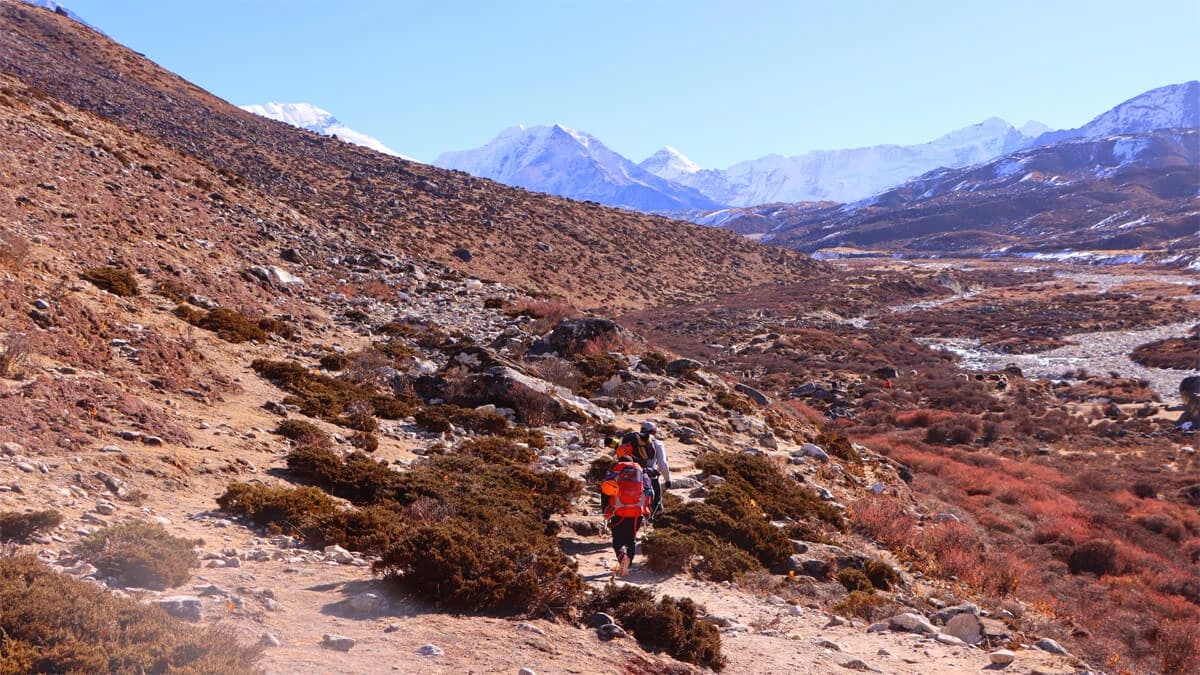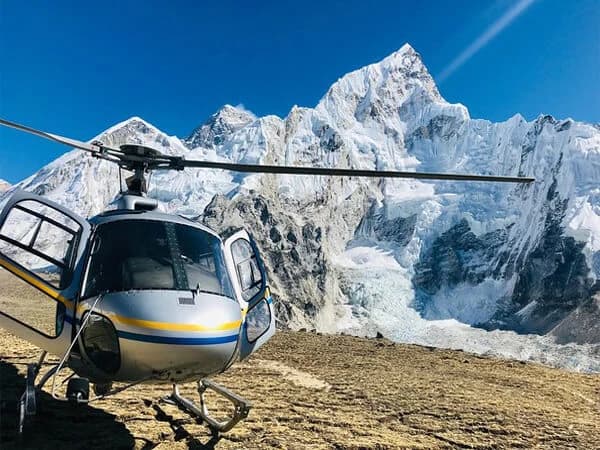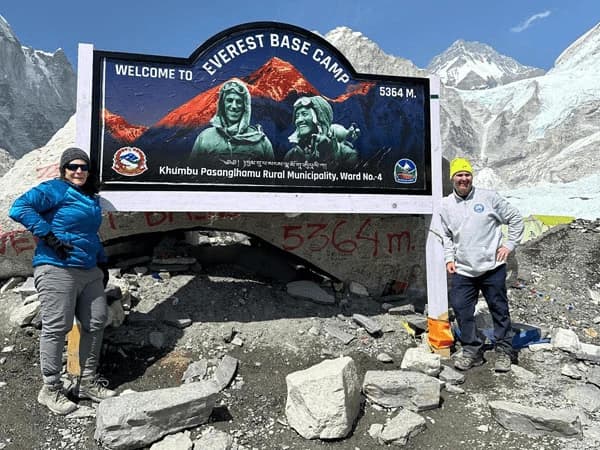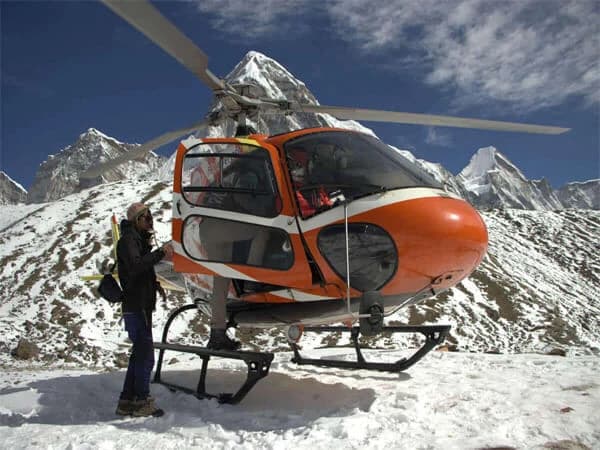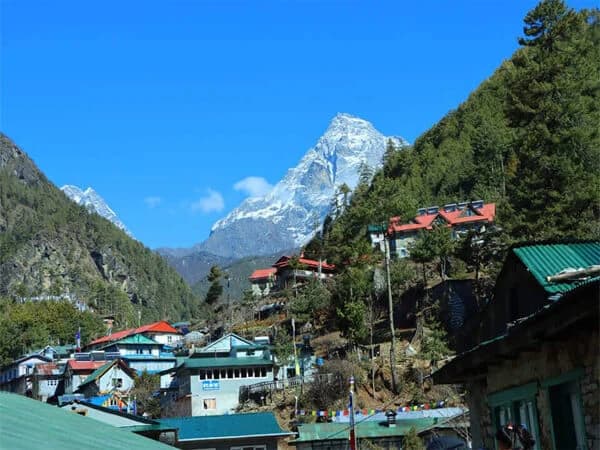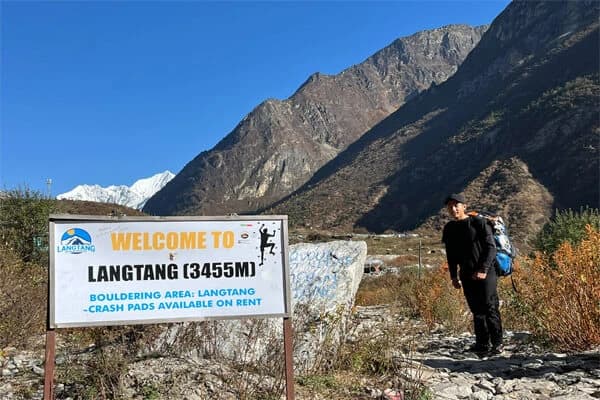Trekking to the Everest Base Camp is a test of fortitude, culture, and scenic beauty. It leads you through the heart of the Khumbu region, where you will walk through a variety of environments, including lush forests and high-altitude tundras, as well as past historic Sherpa communities and revered temples. The trek is just as much about the journey as it is about the destination. It requires time and physical preparation but rewards you with a deep sense of achievement, cultural immersion, and a close bond with the mountains.
On the other hand, the Everest Base Camp Helicopter Tour provides a quick, opulent, and less strenuous way to take in the beauty of Everest. You may take in the expansive vistas of high peaks, glaciers, and profound valleys while soaring above the Himalayas in a matter of hours. This is the ideal choice for people who wish to see the breathtaking scenery of the Everest region but may not have the time or physical capacity to complete the journey. Almost everyone can experience the once-in-a-lifetime opportunity of standing at the foot of Everest without having to endure the arduous journey thanks to the helicopter tour.
There are two very different but equally fascinating ways to take in the majesty of the tallest peak in the world, Mount Everest: the Everest Base Camp (EBC) Trek and the Everest Base Camp Helicopter Tour. Both allow seeing Everest up close and breathtaking views of the Himalayas, but the experiences they offer are customized to meet diverse tastes, schedules, and physical capacities.
Everest Base Camp Trek

The Everest Base Camp Trek is one of the most iconic and sought-after trekking experiences in the world, offering adventurers a chance to stand at the foot of Mount Everest, the highest peak on Earth. This trek is more than just a journey; it's an adventure that takes you through the heart of the Himalayas, where you'll experience the stunning beauty of rugged mountain landscapes, deep valleys, glacial rivers, and ancient Sherpa culture.
Duration
The EBC Trek is a multi-day journey that generally takes between 12 to 16 days to complete, depending on your pace and the itinerary. This includes time for acclimatization, which is crucial for adjusting to the high altitudes. The trek begins with a flight from Kathmandu to Lukla, followed by a trek through the Khumbu Valley, and ends at Everest Base Camp, with a return to Lukla for the flight back to Kathmandu.
Experience
Trekking to the Everest Base Camp is a demanding and engaging adventure. Trekkers cover about 130 kilometers (80 miles) round trip over about two weeks. The trek is physically taxing since it requires hiking over extended periods, frequently across rough and hilly terrain. The world's highest peaks serve as the backdrop for a diversity of environments that you will encounter on the walk, from verdant rivers and forests to barren high-altitude regions.
The air gets thinner as you climb, thus acclimatization becomes crucial during the journey. Trekking over 4,000 meters takes many days, including acclimatization stops at Dingboche and Namche Bazaar to help your body acclimate to reduced oxygen levels. A rich cultural experience is provided by the route's passing through Buddhist temples and traditional Sherpa settlements. An optional hike to Kala Patthar (5,545 meters) offers breathtaking vistas of Mount Everest and the surrounding peaks as the trek comes to an end at Everest Base Camp.
Physical Requirements
The Everest Base Camp Trek demands a high level of physical fitness due to the long days of hiking, significant altitude gains, and challenging terrain. Trekkers need to be prepared for 5-8 hours of walking each day, with elevations ranging from 2,860 meters (Lukla) to 5,364 meters (Everest Base Camp). Altitude sickness is a real risk, especially as you ascend above 3,000 meters, and it’s essential to take precautions, such as following a gradual ascent, staying well-hydrated, and recognizing the symptoms of acute mountain sickness (AMS).
Cost
While the Everest Base Camp Trek is more affordable than the helicopter tour, it still requires a substantial investment. Costs include flights to and from Lukla, permits, guide and porter services, accommodation, food, and equipment. Budget travelers can manage costs by staying in basic teahouses and bringing some gear from home, but overall, the trek is a significant financial commitment.
Pros
- A sense of achievement from completing a challenging trek.
- Deep cultural immersion and interaction with fellow trekkers.
- Spectacular and varied scenery along the route.
Cons
- Physically demanding and time-consuming.
- Risk of altitude sickness and other trekking-related health issues.
Everest Base Camp Helicopter Tour

The Everest Base Camp Helicopter Tour provides a quick and opulent alternative to trekking to fully appreciate Mount Everest's beauty. This journey, which can usually be finished in a single day, allows you to see the Himalayas from above. It involves a direct flight from Kathmandu (or Lukla) to either Kala Patthar or Everest Base Camp. In addition to offering breathtaking aerial views of glaciers, deep valleys, and isolated settlements, the helicopter trip offers breathtaking views of some of the world's highest peaks, such as Mount Everest, Lhotse, and Ama Dablam.
A brief landing at either Kala Patthar or Everest Base Camp is part of the experience, allowing you to go outside and soak in the breathtaking view up close. You will get the opportunity to take amazing pictures during this brief visit, with Everest serving as the backdrop. The helicopter tour is accessible to almost anyone, requiring minimal physical effort, and is a great option for those who might not have the time or physical capability to undertake the rigorous trek to Everest Base Camp.
Even though it costs more than trekking, the helicopter trip is a convenient, pleasant, and unforgettable method for witnessing Mount Everest. For anyone with limited time who wishes to witness the highest peak in the world up close, this journey is perfect. Since you are only exposed to high elevations for a brief period, the helicopter tour also reduces your risk of experiencing altitude sickness.
Highlights of the Everest Base Camp Helicopter Tour
- Discover an angle on the Everest region that is not achievable when trekking on foot.
- Experience magnificent aerial views of some of the world's highest peaks, such as Ama Dablam (6,812 meters), Lhotse (8,516 meters), Mount Everest (8,848 meters), and many more mountains.
- Take an aerial tour of Sagarmatha National Park
- A short landing at either Everest Base Camp (5,364 meters) or Kala Patthar (5,545 meters) and a very broad view of Mount Everest is available from Kala Patthar.
- Taking breathtaking pictures of Everest and the surrounding peaks. The helicopter offers photographers unhindered, unclouded views, which is perfect for them.
- The helicopter eliminates the difficulties of high-altitude walking and offers a pleasant and uneventful experience.
Pros
- Ideal for those short on time or unable to undertake a strenuous trek.
- Incredible aerial views that are impossible to get on foot.
- No need for extensive physical preparation
Cons
- Limited time on the ground at EBC, with no opportunity to explore the area.
- No cultural immersion or interaction with local communities.
- High cost relative to the experience's duration.
Both the Everest Base Camp Helicopter Tour and the Everest Base Camp Trek provide amazing experiences customized to different preferences and abilities. The trek is a difficult and immersive activity that offers fascinating cultural exchanges, a strong sense of accomplishment from the arduous journey, and a profound connection to the breathtaking Himalayas. It is perfect for those who want to experience real trekking and the satisfaction of walking to Everest Base Camp. On the other hand, the helicopter trip offers a quick, wealthy, and convenient method to take in the breathtaking splendor of Mount Everest and the surrounding peaks.
It gives breathtaking aerial views and a spectacular look at Everest with little physical effort, making it ideal for people who are pressed for time or are unable to complete the climb. Both alternatives guarantee an unforgettable experience with one of the most iconic landscapes in the world, whether you pick the helicopter trip for its convenience and stunning views or the trek for its adventure and cultural depth. You may choose Everest Base Camp Trek with Helicopter return to enjoy both trekking and aerial view of mount everest.
FAQs of the Everest Base Camp Helicopter Tour
How long does the Everest Base Camp Helicopter Tour take?
The tour typically takes around 3-4 hours, including the flight from Kathmandu (or Lukla) to Everest Base Camp or Kala Patthar, a brief landing for photos, and the return flight.
What is the best time to take the Everest Base Camp Helicopter Tour?
The best time for an everest base camp helicopter tour is during the pre-monsoon (spring) season from March to May and the post-monsoon (autumn) season from September to November. These periods offer clear skies and optimal weather conditions for the flight and views.
Do I need to be physically fit to take the helicopter tour?
No, the helicopter tour requires minimal physical effort. It is suitable for people of various fitness levels, including those who may not be able to undertake the physically demanding Everest Base Camp Trek.
How much does the Everest Base Camp Helicopter Tour cost?
The cost of the EBC helicopter tour varies depending on the provider and the specifics of the tour. Generally, it ranges from $1,500 to $3,000 per person. The price includes the flight, permits, and sometimes refreshments.
Is there a risk of altitude sickness during the helicopter tour?
The risk of altitude sickness is minimal because the helicopter spends only a short time at high altitudes. However, if you have pre-existing health conditions, it’s advisable to consult with your doctor before the tour.
What should I bring with me on the helicopter tour?
Bring warm clothing, as temperatures can be cold even in the helicopter. It’s also a good idea to carry a camera for capturing photos, and any personal items you might need for the brief stop at Everest Base Camp or Kala Patthar.
Will the helicopter land at Everest Base Camp or Kala Patthar?
The tour usually includes a landing at either Everest Base Camp or Kala Patthar, depending on the itinerary and weather conditions. Both locations offer stunning views and excellent photo opportunities.
Can I take a helicopter tour if I’m traveling alone?
Yes, you can take the tour if you’re traveling alone. Some operators offer private charters, or you may join a group tour, which can sometimes reduce the cost.
Are there any safety considerations for the helicopter tour?
Helicopter tours are generally safe, but it's essential to follow the instructions of the pilot and guide. Weather conditions can affect the flight, so the tour might be rescheduled or canceled if conditions are not suitable.
How do I book the Everest Base Camp Helicopter Tour?
You can book the tour through a travel agency or tour operator that specializes in Himalayan flights. It’s advisable to book in advance, especially during peak seasons, to secure your spot and confirm availability.

